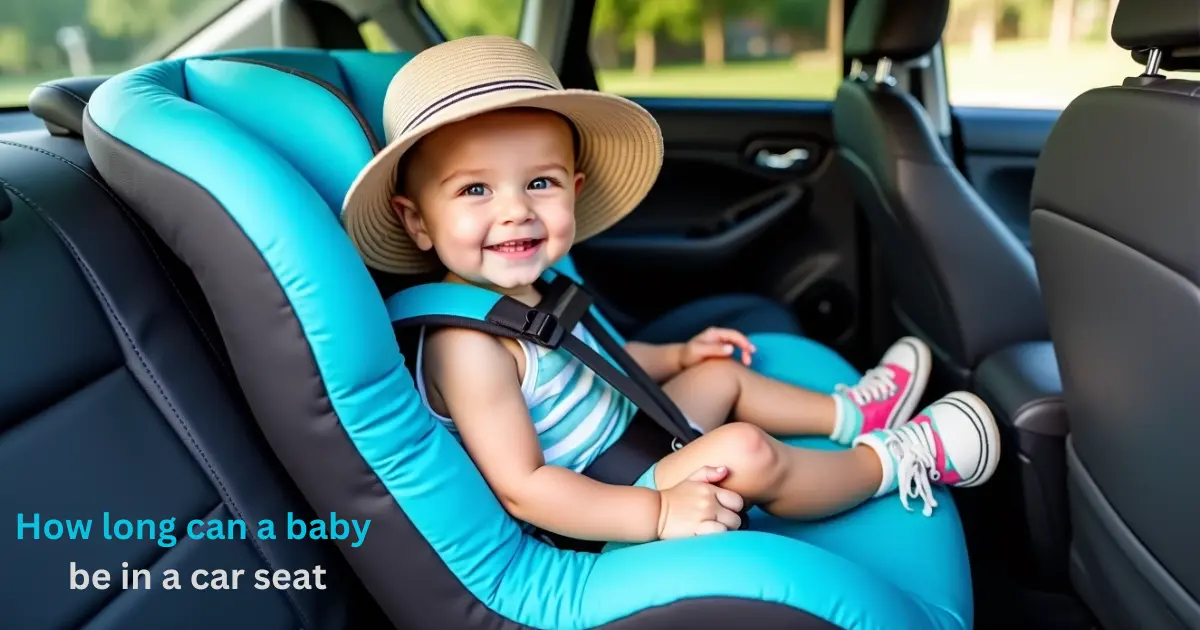Many parents worry about keeping their Baby safe and comfortable during long car rides. In this guide, we’ll break down how long babies can stay in a car seat, the risks of staying in one too long, and simple tips to make travel easier. Whether you’re a new parent or have been through it before, this article will help you understand how long a baby can be in a car seat and how to keep your little one happy on the road.
How Long Can a Baby Be in a Car Seat?
Always remember that how long a baby can be in a car seat depends on the best age to travel with a baby time and the need for regular breaks.
What Experts Say:
The American Academy of Pediatrics (AAP) and the NHS(UK) recommend that babies should not stay in a car seat for more than 2 hours at a time. This is especially important for newborns and young babies because their bodies are still growing and are more at risk of problems like positional asphyxiation. This happens when a baby’s head falls forward, making it hard for them to breathe. Both organizations stress that Car seats are made to keep babies safe during travel, not for long naps or as a bed. On long trips, parents should take breaks to take the Baby out of the seat and let them stretch.
Age Specific Guidelines:
How long a baby can stay in a car seat depends on their age. Here’s what you need to know:
- Newborns (0-3 months): Newborns should only be in a car seat for 30-60 minutes at a time. Their bodies are still very delicate, and their neck muscles aren’t strong enough to support their head for long periods.
- Infants (3-6 months): Babies this age can handle up to 2 hours in a car seat, but they still need breaks. Take them out of their seats, let them stretch, and give them a chance to move around.
- Older Babies (6+ months): Older babies can stay in a car seat a little longer, but breaks are still important. Even though they’re stronger, sitting in one position for too long can make them uncomfortable.
Why Too Long in a Car Seat Can Be Dangerous
Keeping a baby in a car seat for too long can cause problems like:
- Trouble Breathing: If a baby’s head slumps forward, it can block its airway, making it hard for the Baby to breathe.
- Back and Neck Strain: Sitting in the same position for a long time can hurt a baby’s developing spine and neck.
- Overheating: Car seats can get hot, and babies can overheat quickly, which can be dangerous.
Why Is This Topic Important?
Car seats are a must for keeping babies safe in the car, but using them for too long can cause problems. Babies are still growing, and their bodies can’t handle sitting in one position for hours. If their head slumps forward, it can block their breathing, which is called positional asphyxiation. Parents often worry about long trips, but knowing how long can a baby be in a car seat and taking breaks can keep your Baby safe and comfy.
Tips for Safe and Comfortable Long Travels
1. Plan Frequent Breaks
Sitting too long in a car seat can make babies uncomfortable. Stop every 1-2 hours to take them out, stretch their tiny legs, change diapers, or feed them. A quick break also helps prevent crankiness. Even a short cuddle outside the car can make a big difference in keeping your Baby happy.
2. Ensure Proper Car Seat Installation
A loose car seat can be dangerous. Before driving, double check that the seat is tightly secured and tilted at the right angle so your Baby’s head doesn’t flop forward. Always follow the car seat manual and avoid placing the seat in the front. A well installed seat keeps your Baby safe throughout the trip.
3. Use Comfort Accessories
Some simple things can make car rides smoother. Soft neck support keeps your Baby’s head steady, a sunshade blocks bright sunlight, and a car seat mirror helps you check on them safely. Just be sure these items are safe to use with car seats and don’t get in the way of safety straps.
4. Keep the Temperature Comfortable
Babies can get too hot or too cold quickly. Use window shades to block heat, set the AC or heater to a cozy level, and dress your Baby in light layers instead of thick clothes. If needed, place a blanket over the straps, never underneath, to keep them warm without affecting their safety.
5. Entertain Your Baby
A happy baby means a peaceful ride. Soft toys, baby songs, or gentle white noise can keep them calm. If your Baby likes music, play soft lullabies or nature sounds. Avoid noisy or flashing toys, as they can be too distracting. Sometimes, the car’s gentle movement is enough to help them sleep.
6. Monitor Your Baby
Pay attention to signs that your Baby is too hot, is uncomfortable, or needs a break. If they start crying, move a lot, or look too sleepy, stop and check on them.
Mistakes to Avoid When Traveling with a Baby in a Car Seat
1. Choosing the Wrong Car Seat
Not all car seats are the same. If the seat is too big or too small, it won’t protect your Baby the right way. Always check the weight and height limits before buying or using a car seat. Babies should stay in rear-facing seats as long as possible because it’s the safest position.
2. Not Installing the Car Seat Correctly
A car seat that isn’t tightly secured can move around, making it unsafe in an accident. Many parents make mistakes like using loose straps or placing the seat at the wrong angle. Always follow the instruction manual and, if needed, get help from a car seat expert.
3. Buckling the Straps Too Loosely
Loose straps mean your Baby isn’t fully protected. The harness should be snug and lay flat against the body. Try this test: If you can pinch any extra strap material at the shoulders, it’s too loose. Tighten it until it fits properly.
4. Dressing Your Baby in Thick Clothes
Bulky jackets and blankets make the harness less effective. In a crash, thick clothing can squish down, creating extra space, which can be dangerous. Instead, dress your Baby in light layers and place a blanket over (not under) the harness to keep them warm.
FAQs: Baby Car Seat Safety & Comfort
1. When can babies face forward in a car seat?
Babies should stay rear-facing until they are at least 2 years old or until they reach the maximum height and weight allowed for their car seat. Rear-facing seats give better protection in case of an accident.
2. How Do I Know If My Baby Is Uncomfortable in the Car Seat?
Babies can’t always tell you when they’re uncomfortable, but they give clues. Babies can’t always tell you when they’re uncomfortable, but they give clues. Babies can’t always tell you when they’re uncomfortable, but they give clues. Here’s what to look for to ensure your baby is comfortable and safe in a car seat:
- Frequent crying or fussiness: If your Baby is agitated, they might be uncomfortable.
- Sweating or flushed skin: This could mean they’re overheating.
- Arching their back or wiggling: They might be trying to get into a better position.
- Red marks on the skin: This could mean the straps are too tight or rubbing.
- Head slumping forward: This means they need better head support
3. Baby car seat head support: Is it necessary?
Newborns have weak neck muscles, so they need proper head support in their car seats. Most car seats come with built-in support, but if you need extra padding, only use products approved by the car seat manufacturer.
4. Can you Uber with a baby without a car seat?
Rules depend on where you live, but in most places, babies must have a car seat in taxis or ride-sharing cars like Uber. Some Uber drivers offer car seats for an extra charge, but it’s always best to bring your own.
5. How long can a baby stay in a car seat during travel?
Follow the 2-hour rule. Take breaks to remove them from the seat, stretch their body, and prevent breathing issues even if your Baby is asleep.
6. What is the best car seat protector for a baby car seat?
Look for a car seat protector that’s non-slip, waterproof, and approved by your car seat manufacturer. Avoid thick protectors that can interfere with installation.
7. Can babies sleep in car seats?
Car seats are not safe for long naps or overnight sleep. If your Baby falls asleep in the car, take them out as soon as you reach your destination and move them to a crib or bassinet.
8. Installing a baby car seat: How to do it right?
- Installing a baby car seat: How to do it right?
- Read both the car seat manual and the car’s manual.
- Use either the LATCH system or seat belt to secure the seat tightly.
- Make sure the seat does not move more than 1 inch from side to side.
- Check that the reclining angle is correct for newborns.
- If unsure, visit a certified car seat technician for help.
9. What is the best car seat for a newborn baby?
A rear-facing infant car seat is the safest option. Make sure it has a 5-point harness, proper head support, and is installed correctly.
Conclusion
Traveling with a baby means keeping them safe and comfy in their car seat. Babies shouldn’t stay in a car seat too long. For older babies, limit it to 2 hours, and for newborns, just 30 to 60 minutes. Take breaks often, make sure the seat is installed right, and keep your Baby cozy with soft supports and shade. Watch for signs they’re uncomfortable, like crying or sweating, and avoid mistakes like loose straps or thick clothes. With these tips, you can make car rides safer and happier for your little one. Safe travels!






